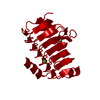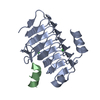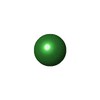+Search query
-Structure paper
| Title | Scaffolding protein CcmM directs multiprotein phase separation in β-carboxysome biogenesis. |
|---|---|
| Journal, issue, pages | Nat Struct Mol Biol, Vol. 28, Issue 11, Page 909-922, Year 2021 |
| Publish date | Nov 10, 2021 |
 Authors Authors | Kun Zang / Huping Wang / F Ulrich Hartl / Manajit Hayer-Hartl /  |
| PubMed Abstract | Carboxysomes in cyanobacteria enclose the enzymes Rubisco and carbonic anhydrase to optimize photosynthetic carbon fixation. Understanding carboxysome assembly has implications in agricultural ...Carboxysomes in cyanobacteria enclose the enzymes Rubisco and carbonic anhydrase to optimize photosynthetic carbon fixation. Understanding carboxysome assembly has implications in agricultural biotechnology. Here we analyzed the role of the scaffolding protein CcmM of the β-cyanobacterium Synechococcus elongatus PCC 7942 in sequestrating the hexadecameric Rubisco and the tetrameric carbonic anhydrase, CcaA. We find that the trimeric CcmM, consisting of γCAL oligomerization domains and linked small subunit-like (SSUL) modules, plays a central role in mediation of pre-carboxysome condensate formation through multivalent, cooperative interactions. The γCAL domains interact with the C-terminal tails of the CcaA subunits and additionally mediate a head-to-head association of CcmM trimers. Interestingly, SSUL modules, besides their known function in recruiting Rubisco, also participate in intermolecular interactions with the γCAL domains, providing further valency for network formation. Our findings reveal the mechanism by which CcmM functions as a central organizer of the pre-carboxysome multiprotein matrix, concentrating the core components Rubisco and CcaA before β-carboxysome shell formation. |
 External links External links |  Nat Struct Mol Biol / Nat Struct Mol Biol /  PubMed:34759380 / PubMed:34759380 /  PubMed Central PubMed Central |
| Methods | EM (single particle) / X-ray diffraction |
| Resolution | 1.63 - 8.0 Å |
| Structure data |  EMDB-12730:  EMDB-12731:  EMDB-12732:  PDB-7o4z:  PDB-7o54: |
| Chemicals |  ChemComp-NI:  ChemComp-CL:  ChemComp-HOH: |
| Source |
|
 Keywords Keywords |  PHOTOSYNTHESIS / protein binding carboxysome PHOTOSYNTHESIS / protein binding carboxysome |
 Movie
Movie Controller
Controller Structure viewers
Structure viewers About Yorodumi Papers
About Yorodumi Papers




